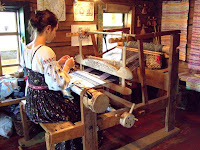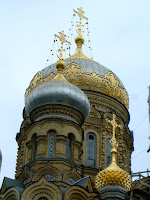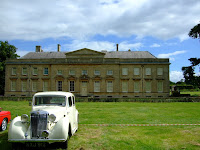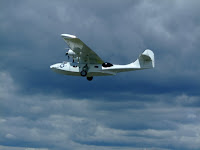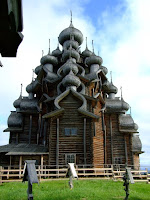

Outside our window when we awoke this morning was the jewel in the crown of Russian wooden architecture and construction,
 the Transfiguration Cathedral on Kizhi Island. This small island, only 6 miles long and one mile wide has now been turned into a heritage museum as a showcase of Russian wooden buildings. The three structures in the church ensemble; the Transfiguration Cathedral (1714), the Intercession Church (1764) and the bell tower (1874) are original but all the other buildings have been moved here from other islands.
the Transfiguration Cathedral on Kizhi Island. This small island, only 6 miles long and one mile wide has now been turned into a heritage museum as a showcase of Russian wooden buildings. The three structures in the church ensemble; the Transfiguration Cathedral (1714), the Intercession Church (1764) and the bell tower (1874) are original but all the other buildings have been moved here from other islands.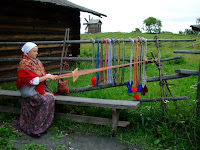 Under restoration at the moment, the Transfiguration Cathedral cannot be visited, only admired from the outside, a fairy tale concoction of stacked octagons crowned with 22 domes clad in thousands of hand cut aspen shingles, it is quite breath-takingly stunning, all the more so when one considers that it was built 300 years ago without nails. Nails were not used as it took 30 minutes to manufacture a nail in the forge and iron or steel was too expensive.
Under restoration at the moment, the Transfiguration Cathedral cannot be visited, only admired from the outside, a fairy tale concoction of stacked octagons crowned with 22 domes clad in thousands of hand cut aspen shingles, it is quite breath-takingly stunning, all the more so when one considers that it was built 300 years ago without nails. Nails were not used as it took 30 minutes to manufacture a nail in the forge and iron or steel was too expensive. The smaller Intercession Church next door was a "summer" church where we were treated to a fabulous a cappella piece by the choir of three monks. Leaving the church complex we visited a typical farmhouse to get an understanding of the life and times of the villagers. The bathhouse on the lake shore was used as a sauna complete with the birch twigs to stimulate blood flow before running down the jetty to plunge into the frigid waters of Lake Onega.
The smaller Intercession Church next door was a "summer" church where we were treated to a fabulous a cappella piece by the choir of three monks. Leaving the church complex we visited a typical farmhouse to get an understanding of the life and times of the villagers. The bathhouse on the lake shore was used as a sauna complete with the birch twigs to stimulate blood flow before running down the jetty to plunge into the frigid waters of Lake Onega. Nearby is a small chapel where we were treated to a bell ringing; a windmill that could be rotated on its axis "by six men, two cows or an angry country woman"; and beyond that the oldest wooden church in Russia, the Resurrection of Lazarus Chapel, thought to be built in the 14th century.
Nearby is a small chapel where we were treated to a bell ringing; a windmill that could be rotated on its axis "by six men, two cows or an angry country woman"; and beyond that the oldest wooden church in Russia, the Resurrection of Lazarus Chapel, thought to be built in the 14th century. As night fell, we were transiting up a staircase of 6 locks on the Volga-Baltic Canal. These six locks raised the ship some 80m so they were impressively deep to sail into, even on the 4th deck we were not level with the cill that the ship would have to sail over at the upper end of the lock.
As night fell, we were transiting up a staircase of 6 locks on the Volga-Baltic Canal. These six locks raised the ship some 80m so they were impressively deep to sail into, even on the 4th deck we were not level with the cill that the ship would have to sail over at the upper end of the lock.

